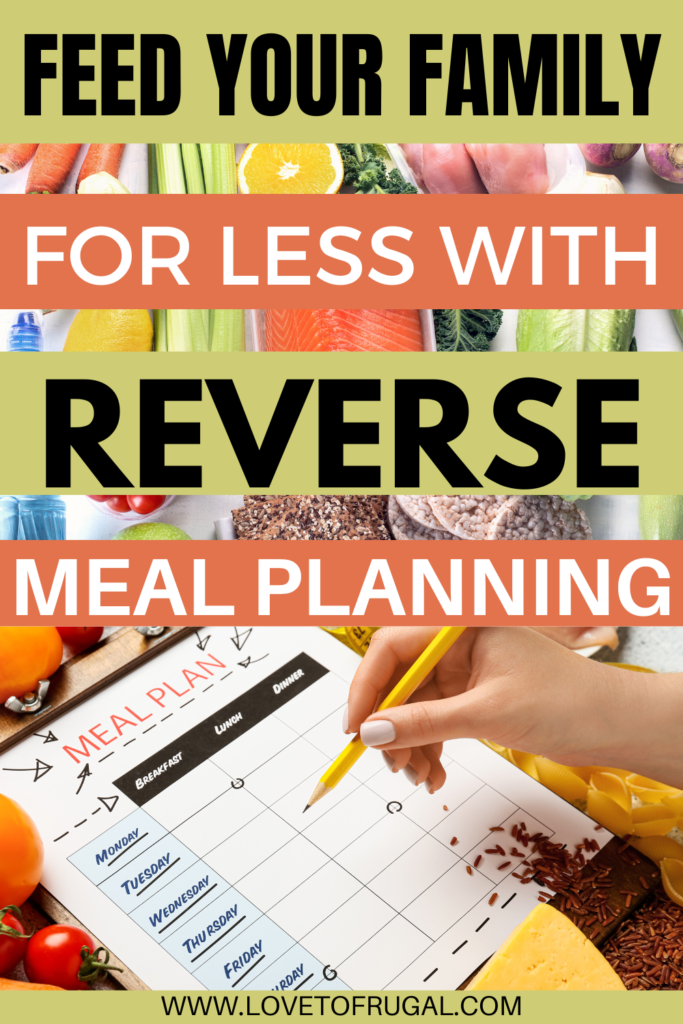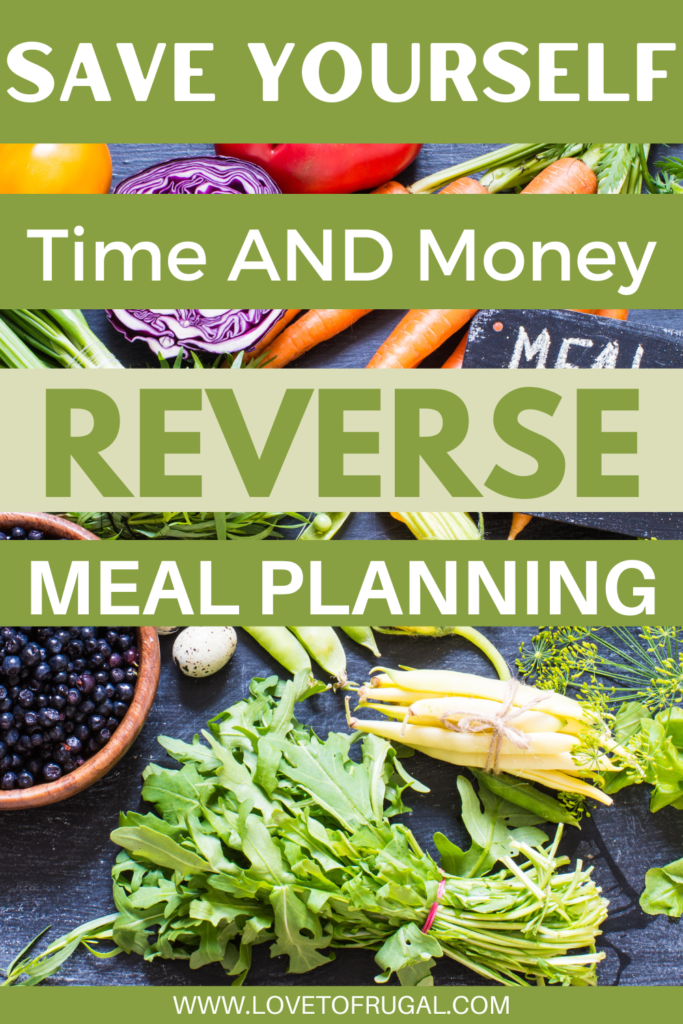Reverse Meal Planning: Easy Solutions To Save Time And Money
Reverse meal planning is a meal planning strategy that I’ve been doing for years. I just didn’t know there was an actual name for it until just a few years ago. My mother did her meal planning this way when I was a kid and I’m know she didn’t have a name for it other than plain old meal planning.
Meal planning, in general, is a powerful tool for saving time, saving money, maintaining a healthy diet, and reducing food waste. However, traditional meal planning involves deciding on meals in advance and then shopping for the necessary ingredients. I think this is where many of us often bottom out and give up. This process may include pulling out cookbooks, scrolling recipes on Pinterest or just asking the family what they’d like to have for dinner. Somehow, that just seems too stressful and troublesome. It can also be expensive. So, the next option is running through a drive through. This is also expensive and can be unhealthy.
But what if I told you there’s a better way?
Enter reverse meal planning. It’s a strategy that involves first assessing what ingredients you have on hand and then planning meals around them.
In this post, I want to get into the concept of reverse meal planning, its benefits, and how you can incorporate it into your routine to simplify your cooking and make the most of your ingredients that you already have on hand.
*This post may contain affiliate links, which means that if you buy a suggested product, I will earn a small commission, at no extra cost to you. For more information, see my disclosure page.

Understanding Reverse Meal Planning:
Reverse meal planning flips the conventional approach to meal planning on its head. Instead of starting with recipes and then shopping for the necessary ingredients (which can be very expensive), reverse meal planning begins by taking inventory of what you already have in your pantry, refrigerator, and freezer. This inventory becomes the foundation for meal creation, as you brainstorm dishes that can be made using those ingredients as the building blocks. This approach not only reduces food waste but also encourages resourcefulness and creativity in the kitchen.
I have to tell you, some of my most creative and delicious meals have come from using this method. When you pull ingredients out of your pantry or refrigerator, and assess what you have, more than likely you’ll find more than a few options.
Benefits of Reverse Meal Planning:
There are numerous benefits to using the reverse meal planning method. Here are some of the main ones that I can think of right off the top of my head:
- Reduces Food Waste: One of the most significant advantages of reverse meal planning is its ability to minimize food waste. By using ingredients you already have on hand, you’re less likely to let perishable items go to waste.
- Saves Time: Traditional meal planning often involves extensive recipe research and multiple trips to the grocery store. With reverse meal planning, you streamline the process by focusing on what you already have, saving both time and energy.
- Sparks Creativity: Working with limited ingredients can ignite creativity in the kitchen. Reverse meal planning encourages you to think outside the box, experiment with flavor combinations, and adapt recipes to suit your available ingredients.
- Saves Money: By making the most of ingredients you already have on hand, reverse meal planning can help you stick to your budget and reduce unnecessary spending on groceries. It encourages mindful consumption and strategic meal preparation, ultimately leading to cost savings over time. Anything that can keep you out of the grocery store is a money saving win!
How to Reverse Meal Plan:
Take Inventory:
Begin by conducting a thorough inventory of your kitchen staples, including pantry items, fresh produce, meats/proteins, and frozen foods. Take note of any items that need to be used soon to prevent spoilage. (This simple task can save you a ton of money at the grocery store, but it’s imperative that you do this BEFORE you go grocery shopping, each time.)
Create a List:
Based on your inventory, compile a list of ingredients that you can incorporate into your meals. Focus on versatile items that can be used in multiple recipes and prioritize perishable items that need to be consumed promptly.
Brainstorm Meal Ideas:
With your list of ingredients as a starting point, brainstorm meal ideas that utilize those items in creative and flavorful ways. Consider simple recipes that require minimal additional ingredients to streamline your cooking process.
If you need some recipe ideas, be sure to check out the ‘Recipe’ section here, on the Love To Frugal blog. Most of my recipes include simple, affordable and minimal ingredients, and many are the very ones I grew up with. They were easy, frugal and would usually feed a crew!
Plan Your Meals
Using your brainstormed meal ideas as a guide, plan out your meals for the upcoming week or however long your planning period may be. Aim for a balanced mix of protein, vegetables, maybe a starch/carb and other essential nutrients to ensure a well-rounded diet.
Be Flexible
Flexibility is key when reverse meal planning, as ingredient availability and preferences may change. Don’t hesitate to make substitutions or adjustments based on what you have on hand.
Don’t be afraid to try new recipes or ideas! If you’re out of something, find out if there’s a way you can create a substitution for it. Did you know you can make your own buttermilk with regular milk and vinegar? If you need an egg for baking, but don’t have one, you can substitute 1/4 unsweetened applesauce or 1/4 cup of plain yogurt in place of the egg.
All you need to do is a tiny bit of research and you can find tons of substitutions (in most cookbooks, on the internet or by asking a seasoned cook) for almost anything! Don’t be afraid to experiment!
Go grocery shopping
Once you know what’s in your pantry, refrigerator and freezer, you can then go grocery shopping. With the reverse meal planning method, you’re shopping to fill in the gaps, not shopping for complete meals. This is where you’re going to save money. Buy what’s on sale. If it’s a really good deal, buy a little more than you would need for say just one meal. When certain meats are on sale, stock up. Then, when you get home, divide it up, freeze and plan meals around that.
Repeat Regularly
Make reverse meal planning a regular part of your weekly routine by setting aside dedicated time each week to take inventory. Then, you can brainstorm meal ideas, and plan your meals accordingly. Adjust your approach as needed based on feedback from your household and what ever your dietary preferences may be.
Example of Reverse Meal Planning
Let’s illustrate the reverse meal planning process with a practical example. Suppose your inventory reveals that you have eggs, bacon, onions, some kind of cheese, and a loaf of bread. With these ingredients, you could plan meals (these would work for breakfast, lunch or dinner) such as:
- Traditional eggs (scrambled, fried, etc), bacon and toast.
- An egg, cheese, onion & bacon omelet with a side of toast.
- An egg, bacon & cheese sandwich on toast or bread. (We called these Breakfast Jacks and would have them with French fries on the side.)
Reverse meal planning offers a easy and sustainable approach to meal preparation that enables you to make the most of the ingredients you already have on hand. By starting with an inventory of your kitchen staples and then creating meals around those items, you can reduce food waste, save time, and allow your creativity to flow.
Lastly…
It’s clear that reverse meal planning isn’t just a cooking technique. It’s a mindset shift that can make you approach mealtime with a more positive attitude. Also, the reverse meal planning method can help you simplify your cooking routine, reduce food waste, and enjoy more satisfying meals all while saving money.
Whether you’re a seasoned home cook or just starting out, incorporating reverse meal planning into your kitchen routine can open up a world of possibilities. It’s all about cooking smarter, not harder and this timeless method fit’s the bill! You’re using what you have, getting creative AND saving loads of time and money! It’s how our grandmas’ meal planned! Here’s to delicious meals and happy cooking!
Do you use the reverse meal planning method or the traditional meal planning method? Let me know in the comments!
If you’d like more money saving, frugal living tips, be sure to subscribe to Love To Frugal so you never miss a post! You can also join our Love To Frugal community by following me on Pinterest, Facebook & Instagram.



I do that but didn’t know it had a name!